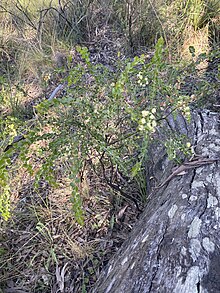Acacia clandullensis, commonly known as gold dust wattle,[1] is a shrub belonging to the genus Acacia and the subgenus Phyllodineae. It is endemic to New South Wales.
| Gold dust wattle | |
|---|---|

| |
| Scientific classification | |
| Kingdom: | Plantae |
| Clade: | Tracheophytes |
| Clade: | Angiosperms |
| Clade: | Eudicots |
| Clade: | Rosids |
| Order: | Fabales |
| Family: | Fabaceae |
| Subfamily: | Caesalpinioideae |
| Clade: | Mimosoid clade |
| Genus: | Acacia |
| Species: | A. clandullensis
|
| Binomial name | |
| Acacia clandullensis B.J.Conn & Tame
| |

| |
| Occurrence data from AVH | |

Description
editThe open pendulous shrub typically grows to a height of 1 to 2 metres (3 to 7 ft).[2] It has slightly ridged densely hairy branchlets that become terete. Like most species of Acacia it has phyllodes rather than true leaves. The evergreen phyllodes are quite crowded and have a circular to broadly elliptic or obovate shape with a length of 0.4 to 1.6 cm (0.16 to 0.63 in) and a width of 3 to 11 mm (0.12 to 0.43 in). The light gren phyllodes are sparsely hairy when young and have a subprominent midvein.[1]
Taxonomy
editThe species was first formally described by the botanists Barry Conn and Terry Tame in 1996 as part of the work A revision of the Acacia uncinata group (Fabaceae-Mimosoideae) as published in Australian Systematic Botany. It was reclassified as Racosperma clandullense in 2003 by Leslie Pedley then transferred back to genus Acacia in 2006.[3] It is quite similar in appearance to Acacia sertiformis.[1]
Distribution
editIt is mostly found in the areas around Clandulla and Glen Davis growing at higher altitudes in stony sandy or clay-loam soils where it is usually part of open Eucalyptus rossii woodland communities.[2]
See also
editReferences
edit- ^ a b c "Acacia clandullensis B.J.Conn & Tame". PlantNet. Royal Botanic Garden, Sydney. Retrieved 28 June 2020.
- ^ a b "Acacia clandullensis B.J.Conn & Tame". Wattle Acacias of Australia. Department of the Environment and Energy. Retrieved 4 April 2019.
- ^ "Acacia clandullensis B.J.Conn & Tame". Atlas of Living Australia. Global Biodiversity Information Facility. Retrieved 28 June 2020.